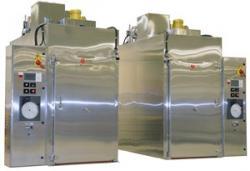Granulation in the Pharmaceutical Industry
In the Pharmaceutical Industry, compromise cannot be allowed regarding the quality of the final product. Tablets and capsules need the proper solubility, granulation, and Aqueous or Solvent solution for bonding. To avoid the chance of thermal decomposition, forms of drying are incorporated after the Aqueous or Solvent solution is applied to the granules. Granulation dryers play an essential role in the pharmaceutical industry for drying wet slurry or caked powder. Batch or continuous drying ovens may be incorporated in production systems for both Aqueous and Solvent-based formulations.
Many factors are taken into consideration when selecting pharmaceutical granulation equipment. Some of those considered for both Aqueous and Solvent based formulations include load size, loading method, bulk density of the powder, and the drying cycle. Below are things to consider when designing a pharmaceutical granulation dryer.
Top 10 Considerations When Designing A Granulation Dryer
-
Load Type: One of the first questions you will be asked during the design process of your pharmaceutical dryer is if your load is a solvent or aqueous based formation. When a solvent is used to bind the granules, then the dry granulation machine will need to meet Class “A” specifications which requires a specified exhaust rate to dilute vapors. A Class “A” pharmaceutical dryer will also require an increased KW rating to compensate for the increased exhaust and deflagration venting relief panels.
-
Total Load Size: The total load size (kg) is used to size your granulation dryer and determine the most effective loading configuration. The total load size will also be used when calculating the airflow rate needed to meet the desired drying cycle time.
-
Wet Weight and Dry Weight: When calculating the granulation drying rate and cycle time, the wet and dry weight of the product is taken into consideration (LOD).
-
Bulk Density: The bulk density is used to determine cycle times and airflow requirements.
-
Heat Type: The thermal input is designed around the facility requirements, so it is necessary to know if the customer will be using steam, hot water, or electric as the heat source.
-
Process Temperature: The dryer will be designed with the ability to achieve the desired process temperature for drying the load.
-
Drying Cycle: The control system will be designed around the granulation drying cycle. The airflow rate will be sized to keep the dry granulation from becoming airborne as the slurry is dried.
-
Loading Method: The method of loading is important to determine the necessary airflow arrangement for drying the load. If the granulation dryer will be truck loaded, then a walk-in style dryer will be needed. The design team will also need to plan for adequate spacing between shelves on load trucks for optimum drying.
-
Delivery and Installation: The final location of the equipment will need to be taken into consideration to ensure the unit it sized to fit the footprint where it will be installed. Entry widths and heights are also important to confirm that the equipment can fit through door and passageways into the facility.
-
Cabinet Style: A cabinet style granulation dryer is a more compact and designed for R&D and smaller kg loads. This style also requires less floor space and may be ideal for smaller facilities. A cabinet style granulation dryer would not be an option if the customer has a larger kg load and prefers using a truck loading method.




